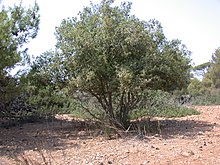Quercus calliprinos
This article needs additional citations for verification. (July 2015) |
| Israeli oak | |
|---|---|

| |
| Scientific classification | |
| Kingdom: | Plantae |
| Clade: | Tracheophytes |
| Clade: | Angiosperms |
| Clade: | Eudicots |
| Clade: | Rosids |
| Order: | Fagales |
| Family: | Fagaceae |
| Genus: | Quercus |
| Subgenus: | Quercus subg. Cerris |
| Section: | Quercus sect. Cerris |
| Species: | Q. calliprinos
|
| Binomial name | |
| Quercus calliprinos | |
Quercus calliprinos, the Israeli oak, is an oak classified as part of the Cerris section of the genus. It is native to eastern Mediterranean region and southwest Asia, and grows all across the Middle East from northern Algeria to Turkey and further eastwards. In Israel it is called the common oak (Hebrew: אלון מצוי, IPA: [a'lon ma'tsuj]).
It grows in the Mediterranean climate zone, mainly on limestone, in mid-elevations, often dominating the flora, alongside Pistacia palaestina.[1]
Description
Quercus calliprinos is a small to medium-sized tree or large shrub reaching 5–18 m tall (often only 1–3 m tall where heavily browsed by goats) and 1 m trunk diameter. It is evergreen, with spiny-serrated leaves 3–5 cm long and 1.5–3 cm broad. The acorns are 3–4 cm long and 2–3 cm diameter when mature about 18 months after pollination, held in a cup covered in dense, elongated, reflexed scales.
Quercus calliprinos is closely related to the Kermes oak (Q. coccifera) of the western Mediterranean, and is treated as a subspecies or variety of it by some botanists. The Kermes oak is distinguished from it by its smaller size (usually shrubby, not over 10 m) and smaller acorns less than 2 cm diameter.

References
- ^ Zohary, M. "The maquis of Quercus calliprinos in Israel and Jordan." Bulletin of the Research Council of Israel 9.2 (1960): 51-72.
